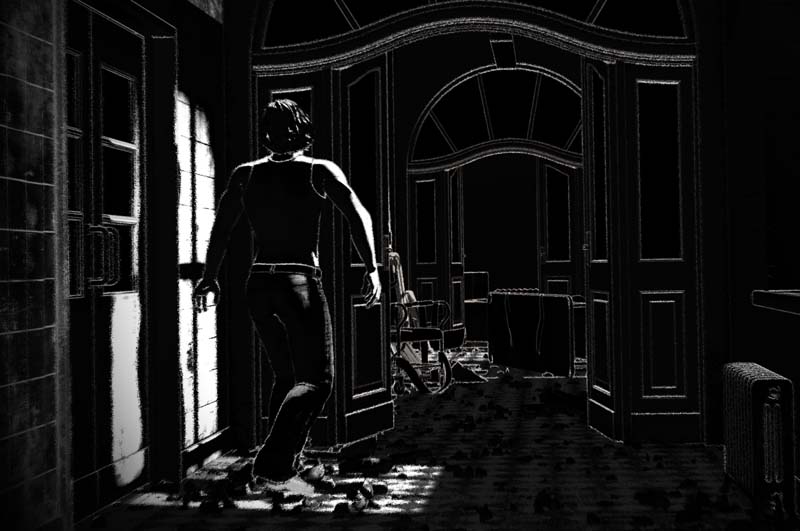I spent the day working on artwork. While Accused: A Black Skull Short Thriller, is now available for Kindle on Amazon, I am planning a print copy of the book. This image is an experiment in mood, shading, and texturing, and I plan on having similar artwork in the print version of Accused. While the above image is unrelated to the Black Skull, it does capture the dark look and harsh lighting of a typical film-noir or comic-book noir illustration. I will be posting more images for the Black Skull and other work here and I would really appreciate your feedback. Let me know what you think in the comments below.
Breaking Radio Silence…
It’s been a bit quiet here on Andron.ca for the past month. April has been a remarkably productive period for me.
In the past month, I have completed a short novel, created two pieces of cover art, and completed a motion capture collection. So yeah, productive’s the right word.
I’m going to talk a little bit more about the novel later on as we get closer to release, but it’s enough to say that I was able to put this together very quickly. I got started doing the plotting on it in mid-January, and then proceeded to write fairly regularly over the next month and a half. The last month and change has consisted of doing revisions and tweaking of the novel to get it ready for release. I also wanted to make sure that I left enough time for the novel to sit so I could give it an effective proofreading before doing the final release.
Now, it becomes a matter of putting together the website and other promotional materials and going through an entire preflight checklist of all of the various details that have to be ready prior to the book’s release. It’s been a very interesting project to work on, and I’m looking forward to finally getting it out into the public’s hands.
So, what’s next?
I have a second novel that has been completely plotted, and I’m already starting to work on it. I’ve also taken on a larger project, which is scripting a web series. The multi-episode web series is going to be a challenge to write, simply because of the combination of structure and length. The outline for the the web series should be completed completed within the next two weeks, and the script itself done ideally by the end of June. Then, I can start taking a look at various production options.
As part of the development process, I’m going to be making regular posts on the blog describing the progress of each stage of this web series. I’m not going to talk about the subject matter of the series, at least not yet. Ideas can be delicate things, and they can lose their luster if they’re shared among too many people.
Besides, I have often found that simply having the idea isn’t enough. You have to get it to a prototype stage before you can start really working it and discovering its true potential. Once you have it in a concrete form, no matter how rough, the idea acquires substance at that point. Then, and only then, are you able to start polishing it until it shines.
Also, when you have it in a concrete form, that gives you credibility when you show it to others for their help in taking the idea to the next stage. While there are people who are able to excite others just on the strength of their oratory and ephemeral ideas, I’m not one of them. Like I’ve written in the past, ideas can be like drinking from a firehose. They can come all at once and flow down the drain just as quickly. Managing that creative flow is a sign of real professionalism.
In my next post on this, I’ll talk about the scope of the project. That will give you an idea of the challenge that awaits over the next couple of weeks.
Silent Shadow of the Bat-Man Fanfilm
Not quite fanfilm, not quite mashup, the movie Silent Shadow of the Bat-Man is actually a work of art. Filmmaker Andre Perkowski brought together a series of silent films from the 1920s and 1930s to tell his own version of the Batman story. The results are spellbinding. Everything from the moody style reminscent of Murnau’s Nosferatu to the haunting music is expertly blended together into a Film showing what the Batman would have been like for a silent film audience.
Considering that the Batman was actually first published in May 1939, silent films were long since replaced by talkies and studios were already releasing big-budget color films using the three-strip technicolor in the mid-1930s, there would never have been a silent Batman film.
Have some fun looking at these clips and reminiscing about a film that could have been but never was. Just like the time in 1946 when Orson Welles was looking at producing a Batman movie.
[youtube id=”U_bjAhynSrY”]
[youtube id=”ByTfwmyHr3Q”]
[youtube id=”JD4XqYT1-JU”]
[youtube id=”SIWf6PHYsVk”]
[youtube id=”j6LtbEWwcfc”]
Oh, you never heard about that? For good reason – it never happened. The Orson Welles Batman project was the creation of Mark Millar in 2003, where he penned a column that was essentially a hoax. But what a hoax it was. Here’s a page that describes the Batman Orson Welles hoax in detail.
Let’s file that under movies that should have been, but never were.
Enjoy the film.
“According to the article, Welles had talked George Raft signing up for the role of Two-Face, James Cagney as The Riddler, Basil Rathbone as The Joker and (get this) Marlene Dietrich as Catwoman!
As to the role of Batman, the column said that was a sticking point between Welles and the studio.
Welles wanted to portray Batman and Bruce Wayne, and the studio wanted Gregory Peck.”
The ARKOFF formula
As a person who grew up reading comics, and modern pulp, I consumed adventure-based storytelling. It wasn’t until much, much later that I became aware of the Arkoff formula and what it means for storytelling. Following the formula gives a chance at an exciting and entertaining story – a chance that can be developed by having good writing, craft, and concept.
Bad writing? Well, let’s just say that there isn’t a formula in the world that can salvage bad writing
Samuel Arkoff founded American International Releasing in the 1950s, and produced over 500 films in his career. He made a practice of pre-selling films to audiences before making them so that he was profitable before even the first frame was shot.
He had a formula for success in a movie that also applies to books. Though many authors are reluctant to use the concept of formula in their work, at the end of the day, I would look at formula as a list of ingredients that you can mix and match any way that you want and use to build a story the way that you want. Rather than seeing a formula as restrictive by saying that you must have each and every element in there, I would approach it as liberating by seeing how each element can be added–if it needs to be added at all.
Now, I have only one commandment of storytelling:
ARKOFF and What it Means
Arkoff broke his name into an acronym and explained it thusly:
ACTION: A good story keeps moving the plot forwards, preferably at a breakneck speed so that the audience can’t wait to see what happens next. Even if two characters are sitting at a table, there should still be action in the form of verbal jousting and the dance of verbal subtext between the characters.
REVOLUTION: Revolutionary ideas and concepts should be brought into the story. Show the audience something interesting, something they may never have thought of before. Make it something that resonates with them. Don’t rely on old tropes, whether you repeat them or subvert them. Instead, push for something new.
KILLING: Arkoff did B-movies by the dozen, and went through entire swimming pools of stage blood, so he tended to focus more on the teenage audience that for some reason loves to see people slaughtered. For our purposes, look at killing in terms of the stakes facing your characters–what is so important that it is worth killing for? What is so important that one of your protagonists would kill–or worse?
If you are going to kill your characters, then make sure that it’s an interesting death that does move the story forwards. Make sure that each death has something to say about the deceased, or the person who killed them. Even in the middle of a brutal combat scene, there should still be a sense that the death diminishes us, or is justly deserved because of the path the character took.
Avoid “tells” which can foreshadow the death of the character (e.g. the cop three days from retirement, or one who just bought a boat) unless those tells resonate with the theme of your story.
ORATORY: Although Arkoff used Oratory in talking about the movie he was producing at the time, I think that it’s equally important to have your character speak well. Give them memorable lines. Let them speak with layers of subtext. Make the dialogue more than interesting–make it fascinating in a way that has your readers quoting their favourite lines of dialogue back to them. Nobody is going to care that you found the right adjective to describe your character, but they will remember your character’s dialogue if you make it good enough.
FANTASY: All of us have fantasies and want to experience them vicariously through others. Find which fantasies resonate with your audience and give them the opportunity to live those fantasies through the eyes of your characters. You are not just telling a story, you’re selling dreams to people. Whether they want to be the farmboy who wants to get off planet and fight a distant rebellion, the woman who finds out that she has the opportunity to show up the snooty prom queen at her high school reunion, or a man who wants to take violent and bloody revenge on the people that murdered his wife and daughter, write in ways that let audiences experience those fantasies.
FORNICATION: Yes, fornication. Sex appeal is an important part of the fantasy element. But we’re not necessarily talking about full, raunchy sex scenes that would make a porn star blush. What we’re talking about is sultry, sexy, sensual–the heat that comes from desire rather than the sweat that comes from the sex itself. Focus on the seduction, not on the sex. Let the audience fill in the details with their imagination–they will thank you for it.
Before we abandon fornication as a topic, there are two things to consider. First, does the sex move the story forwards, or is it just tacked in there in order to spice up a dull plot? A scene written where a woman has sex with a man she despises to keep the man from hearing the conversation of her co-conspirators in the next room pushes the plot forwards and also reveals something about the character. A scene written where a man and woman stop in the middle of a madcap race to stop an atomic bomb from detonating to have passionate sex is bad plotting.
Incidentally, the proper response to being propositioned for sex because “We might not live through the night…” is “GODDAMMIT! Quit Whining! Defuse the bomb and then we’ll celebrate.” Just saying…
The second thing to consider about sex is whether it ties into the fantasies of the reader. Harlequin has managed to build a very successful multimillion dollar business by having a very rigid blueprint designed to appeal to their female marketplace. Many of their series feature sex as fantasy fulfillment using the “heat of the moment” to allow the heroine to be swept away by her passions. And you can almost predict right to the page where the first sex scene occurs. The point is to know your readers and their fantasies and to allow the fornication to appeal to those fantasies.
So, What Do We Do with the ARKOFF Formula?
Well, we have the formula, so we can mix and match elements as needed in order to get an entertaining story, but I don’t think that’s enough. Anyone can pick up a hammer and start nailing 2×4’s together but that’s a long way from framing a house. Understanding the theory behind structure, and load, and even how the wood beams curve is all necessary.
The formula is simple enough that anyone can follow it. To master it, we have to understand what’s behind it. Take a look at all of the elements there, and see what the commonality is.
It’s vicariousness. It is allowing the reader or the viewer to live out exciting experiences through the eyes of the story’s characters. Vicariousness allows the audience to feel the thrill of being hunted, or of seduction. It allows them to imagine what it’s like to say memorable words, and to imagine the unimaginable. It takes them outside of their lives, and lets them experience excitement. It lets them watch bad things happening to someone else, far away, and see how that person triumphs against the bad things.
It goes back to the one commandment: “First, I shall entertain.”
Shut up and eat your awesome…
It’s no secret that there has been an explosion in creativity with Youtube, and that the internet is awash with films that would never have seen the light of day in even fifteen years ago, no matter how good the film was. And what makes it even better is that the films look as good as, if not even better than, the multi-million dollar feature films that sell out the movie megaplexes. Case in point is this film:
[youtube https://www.youtube.com/watch?v=qF4_3y7Kw88]
Talk about high-concept! And it speaks right to the heart of nostalgia where every kid had sat watching Saturday morning cartoons wolfing down a bowl of cereal. Hell, there were Saturdays I practically lived on Count Chocula cereal. And the filmmakers here have taken the concept in directions that would make action-movie filmmakers choke up with pride that their art has been brought to the screen this way.
I know it’s just a trailer, but I would really love to be able to see a full movie like this.



